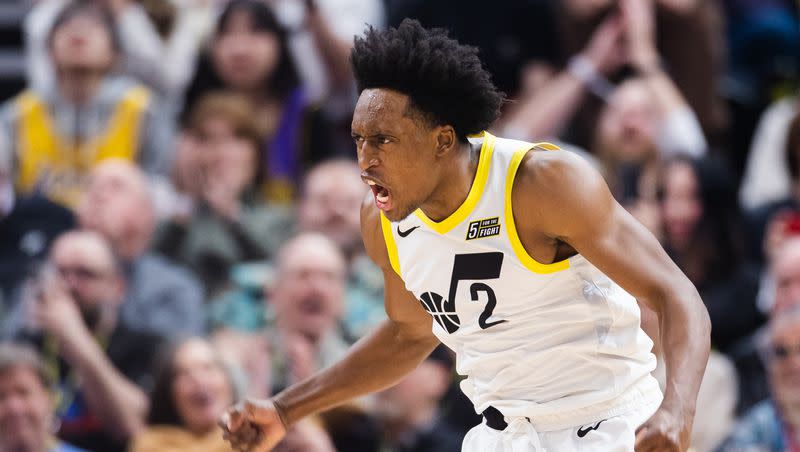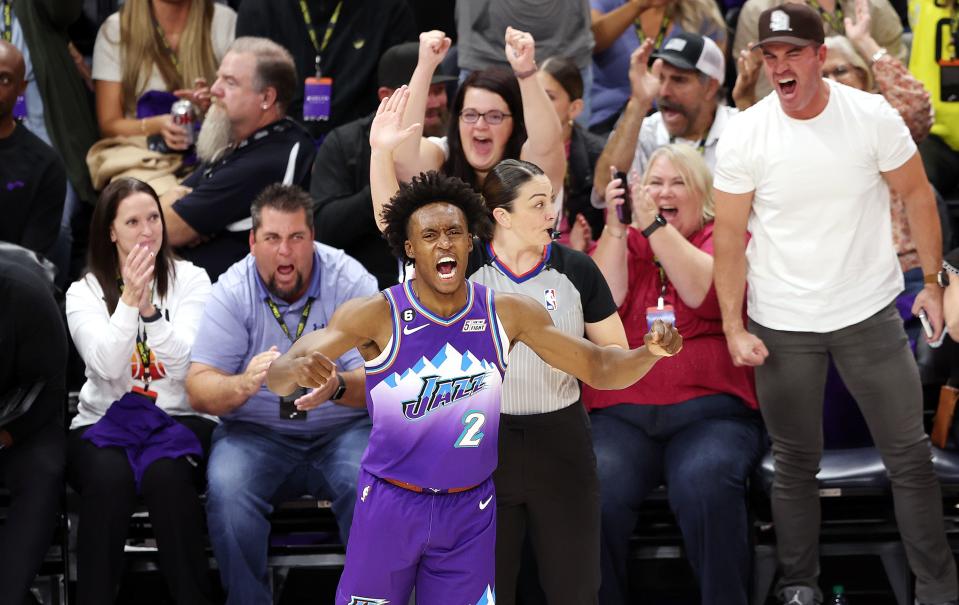Grading the Jazz: Collin Sexton showed some real improvement despite his limited season

Editor’s note: Tenth in a series evaluating and grading every player that was on the Jazz’s final 2022-23 roster.
When the Utah Jazz traded Donovan Mitchell to the Cleveland Cavaliers they got a lot in return that were intriguing for different reasons. There were the haul of draft picks, helping to bolster the asset capital the Jazz were amassing, Lauri Markkanen, who they saw taking on an expanded role, rookie Ochai Agbaji, who they saw a ton of potential in, and Collin Sexton.
Sexton had been a lightning rod of a scorer and a skilled player, but he’d only played 11 games in the 2021-22 season before being sidelined because of a torn meniscus.
Collin Sexton — Grade: B
I’ve covered a lot of basketball players and I don’t know that I can say I’ve ever met one as hungry and as outwardly in love with the game of basketball as Sexton. He loves the game and when he can’t play he is antsy and engaged and on the edge of his seat. Needless to say, this was a difficult season for Sexton.
The Jazz were very cautious with him this season. They wanted to bring him along slowly, and protect him from himself a little bit. He uses his burst and speed as weapons and is an incredibly explosive player. Coming off of having not played for almost a year, it was important for the Jazz to hold Sexton back.
With the way that Sexton plays, it didn’t really come as much of a surprise to me that he had a couple of strains and was still getting his muscles used to his normal workload. And, in order to protect Sexton and to ensure that he’d be even more healthy heading into next season, when he did experience some pain in his hamstrings, the Jazz were extra, extra cautious.
With all of that in mind we have to look at Sexton’s 2022-23 season in two small chunks. He played a total of 48 games — the first 27 games of the season, then he was sidelined for a while with a right hamstring strain before coming back for five games, sitting for a few more and then playing 15 more before he pulled his left hamstring.
Sexton did come back after that second hamstring injury to play in a final game near the end of the season, but for the purposes of this evaluation we’re going to leave out that final game and look at the first chunk of 27 and then the next 20 games he played.
It’s important to remember that those first 27 games were after nearly a year away from competitive basketball. During that stretch Sexton averaged 14.3 points, 3.0 assists, and 1.8 turnovers per game while shooting 49.3% overall and 36.2% from 3. While with Cleveland Sexton had a higher production but he was playing about 10 minutes less per game with the Jazz and mostly coming off the bench.
To be able to keep up his efficiency and to play at the speed he was playing, I thought it was a pretty good performance, and his passing and decision-making was honestly better than I expected it to be.
When the first hamstring injury hit there was a worry that Sexton would take a step back but Sexton was so intentional with his work and rehab and even told reporters that he believed he was improving his shot and his footwork even without being able to play.
During that 20-game stretch after being sidelined, again mostly coming off the bench, Sexton shot 52.7% overall and a staggering 47.9% from 3-point range.
Sexton still averaged 1.8 turnovers per game in that second stretch, and if he’s going to be a primary ball-handler, not only would I like to see his assist numbers go up, but he’ll need to take better care of the ball. I say all of that while also factoring in a bit of grace in this area considering how much time he was actually not playing.
When looking forward, Sexton is really intent on becoming a better facilitator and maximizing his talent as a point guard. He mentioned how much working with Mike Conley early in the season was helpful for him and he continues to watch film on Conley to try to replicate his game.
“Decision making, picking and choosing when to drive, when to attack but also when, with time and score, to set up my teammates and make sure that they’re rolling,” Sexton said. “Watching Mike last year, how he set up Lauri (Markkanen), and how he made sure everyone was eating at certain times … as well and just watching his pace. Like you could never speed him up or slow him down.”
When looking at how much Sexton was able to maintain efficiency and production in a smaller role, being held back, and while dealing with injuries and being out for extended stretches, it’s hard to really dock him points. There’s certainly room for improvement, but it feels like he knows that and is working to expand his game.
Though the Jazz would have liked to have Sexton play closer to a full season, he’s heading into the offseason healthy and pain free and ready to get going on training for next year.
Related
Grading the Jazz: Talen Horton-Tucker still has a lot to prove
Grading the Jazz: Kelly Olynyk proved he has something left in the tank
Grading the Jazz: Why Simone Fontecchio’s first year in the NBA was such a ‘weird season’
Grading the Jazz: What the Jazz learned about Damian Jones in 7 minutes and 40 seconds
Grading the Jazz: Luka Samanic and Kris Dunn showed some definite upside
Grading the two Jazz players who were on expiring contracts this year
Grading the Jazz: Ochai Agbaji was the Jazz’s slow burn success story this season


